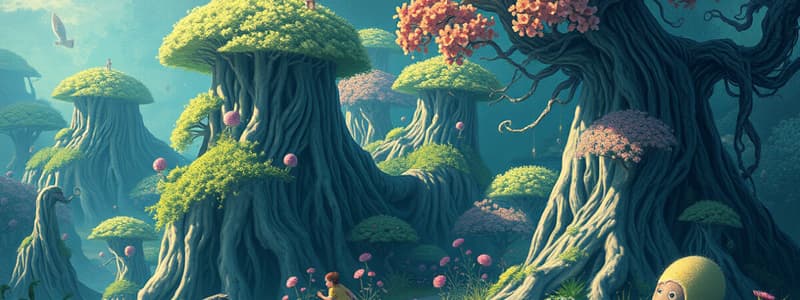Podcast
Questions and Answers
What is ecology?
What is ecology?
The scientific study of interactions among and between organisms and their physical environment.
Match the levels of organization from smallest to largest.
Match the levels of organization from smallest to largest.
Organism = Smallest level of organization Population = Group of individuals of the same species Community = Group of different populations in an area Ecosystem = Community plus physical environment Biome = Group of ecosystems with similar climates Biosphere = The entire planet with all organisms
What defines a population?
What defines a population?
A group of individuals that belong to the same species and live in the same area.
What is a community?
What is a community?
What is an ecosystem?
What is an ecosystem?
What is a biome?
What is a biome?
What is the biosphere?
What is the biosphere?
What is a food chain?
What is a food chain?
What is a food web?
What is a food web?
What are primary producers?
What are primary producers?
Primary producers get their food from which organisms?
Primary producers get their food from which organisms?
What are primary producers for land?
What are primary producers for land?
What are primary producers for water?
What are primary producers for water?
What is a consumer?
What is a consumer?
Which of the following are types of consumers? (Select all that apply)
Which of the following are types of consumers? (Select all that apply)
What do carnivores do?
What do carnivores do?
What are scavengers?
What are scavengers?
What do herbivores obtain their energy from?
What do herbivores obtain their energy from?
What defines omnivores?
What defines omnivores?
What are decomposers?
What are decomposers?
Why are decomposers important?
Why are decomposers important?
What is another name for consumers?
What is another name for consumers?
What is another name for autotrophs?
What is another name for autotrophs?
What are trophic levels?
What are trophic levels?
How much energy is generally passed to each level of a food chain?
How much energy is generally passed to each level of a food chain?
What is the greenhouse effect?
What is the greenhouse effect?
What is an abiotic factor?
What is an abiotic factor?
What is a biotic factor?
What is a biotic factor?
Which of the following are examples of abiotic factors? (Select all that apply)
Which of the following are examples of abiotic factors? (Select all that apply)
Which of the following are examples of biotic factors? (Select all that apply)
Which of the following are examples of biotic factors? (Select all that apply)
What is the predator/prey relationship?
What is the predator/prey relationship?
What happens if there is an increase in predators?
What happens if there is an increase in predators?
What happens if there is a decrease in predators?
What happens if there is a decrease in predators?
What is symbiosis?
What is symbiosis?
Study Notes
Ecology Overview
- Ecology is the scientific study of interactions among organisms and their physical environment.
Levels of Organization
- Organization levels range from smallest (organism) to largest (biosphere) including:
- Organism
- Population
- Community
- Ecosystem
- Biome
- Biosphere
Population
- A population consists of individuals of the same species living in a specific area.
Community
- A community is made up of different populations occupying the same area.
Ecosystem
- An ecosystem comprises a community of organisms interacting with their environment.
Biome
- A biome is defined by a group of ecosystems sharing similar climates and organisms.
Biosphere
- The biosphere encompasses the entire planet along with all its organisms and environments.
Food Chains and Food Webs
- A food chain details steps where energy transfers through eating and being eaten.
- A food web connects all food chains in an ecosystem, showing energy interactions among animals.
Primary Producers
- Primary producers are the first energy-rich compound producers; known as autotrophs.
- Land primary producers are primarily plants.
- Aquatic primary producers are mainly algae.
Consumers
- Consumers are organisms that rely on others for energy and nutrients; known as heterotrophs.
- Types include:
- Carnivores: kill and eat other animals.
- Scavengers: consume carcasses of dead animals.
- Herbivores: feed on plants.
- Omnivores: eat both plants and animals.
- Decomposers: break down organic matter (e.g., bacteria, fungi).
- Detritivores: consume decomposers in detritus.
Decomposers
- Decomposers are critical for nutrient recycling, breaking down dead matter into usable nutrients for ecosystems.
Energy Transfer
- Energy transfer between trophic levels in a food chain is approximately 10%.
Greenhouse Effect
- The greenhouse effect involves gases like carbon dioxide and methane trapping sunlight energy as heat in the atmosphere.
Abiotic and Biotic Factors
- Abiotic factors are nonliving environmental components (e.g., sunlight, soil type).
- Biotic factors include all living things in an ecosystem (e.g., animals, plants).
Predator/Prey Relationships
- Predation occurs when one organism (predator) captures another (prey).
- An increase in predator populations leads to diminished prey availability.
- A decrease in predator populations results in a surplus of prey.
Symbiosis
- Symbiosis refers to a close relationship between two species, which can include mutualism, commensalism, or parasitism.
Studying That Suits You
Use AI to generate personalized quizzes and flashcards to suit your learning preferences.
Description
Test your knowledge of ecology with these flashcards covering key definitions and levels of organization. Perfect for students looking to review essential concepts in biology. Challenge yourself to remember important terms and their meanings related to ecological interactions.




